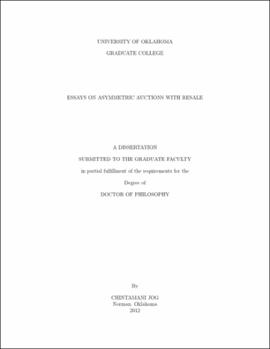| dc.contributor.advisor | Kosmopoulou, Georgia | |
| dc.creator | Jog, Chintamani | |
| dc.date.accessioned | 2019-04-27T21:39:12Z | |
| dc.date.available | 2019-04-27T21:39:12Z | |
| dc.date.issued | 2012 | |
| dc.identifier | 9955006302042 | |
| dc.identifier.uri | https://hdl.handle.net/11244/319271 | |
| dc.description.abstract | This study investigates asymmetric auctions with resale using controlled laboratory experiments. In the first essay titled “ Auctions with Resale: An Experimental Study”, we study the bidding behavior in first price asymmetric auctions followed by resale markets wherein bargaining power varies from seller to buyer. Building upon current literature, we posit a revenue–efficiency trade–off between the resale regimes with either the seller (Monopoly resale) or the buyer (Monopsony resale) has all bargaining power. The results imply a symmetrization of bids for both the bidders under both regimes. Using controlled experiments that mimic the theoretical setting, we find support for higher bidding under the monopoly resale regime with similar efficiency levels across the two resale regimes. Then we employ quantile regression analysis by controlling for certain bidder specific and auction specific characteristics to provide limited evidence for symmetrization. | |
| dc.description.abstract | The second essay, “ Bargaining in Auctions with Resale”, extends the analysis to a double auction (DA) framework in the resale stage that gives both, buyer and seller equal bargaining power. The theoretical results indicate that the equilibrium bidding functions and the resale prices under the DA regime fall in between those from the monopoly and monopsony regimes and the bid–symmetrization property continues to hold in this case as earlier. After running experiments similar to earlier setup, we do not find much support for symmetrization. However, there is limited evidence for a transition of average bids and resale prices across regimes. | |
| dc.description.abstract | The final essay, “ Emission Trading Schemes as Auctions with Resale”, reviews emission trading schemes (ETS) as auctions with resale and examines the results from RGGI (Regional Greenhouse Gas Initiative, an ongoing ETS in the United States) in the light of previous analysis. The trend of RGGI allowance prices indicates a scenario closer to monopsony resale regime. | |
| dc.format.extent | 132 pages | |
| dc.format.medium | application.pdf | |
| dc.language | en_US | |
| dc.relation.requires | Adobe Acrobat Reader | |
| dc.subject | Auctions--Mathematical models | |
| dc.subject | Information asymmetry | |
| dc.subject | Emissions trading | |
| dc.title | ESSAYS ON ASYMMETRIC AUCTIONS WITH RESALE | |
| dc.type | text | |
| dc.type | document | |
| dc.thesis.degree | Ph.D. | |
| ou.group | College of Arts and Sciences::Department of Economics | |
